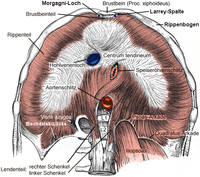
Photo from wikipedia
INTRODUCTION Indications for thoracoscopic versus open approaches to repair congenital diaphragmatic hernia (CDH) are unclear as the variability in defect size, disease severity and patient characteristics pose a challenge. Few… Click to show full abstract
INTRODUCTION Indications for thoracoscopic versus open approaches to repair congenital diaphragmatic hernia (CDH) are unclear as the variability in defect size, disease severity and patient characteristics pose a challenge. Few studies use a patient and disease-matched comparison of techniques. We aimed to compare the clinical outcomes of open versus thoracoscopic repairs of small to moderate sized hernia defects in a low risk population. METHODS All neonates receiving CDH repair of small (type A) and moderate (type B) size defects at an academic children's hospital between 2006 and 2016 were retrospectively reviewed and analyzed. Patients <36weeks gestation, birth weight <1500g, or requiring extracorporeal life support were excluded. Demographics, including CDH severity index, and hernia characteristics were recorded. The primary outcome parameter was recurrence. Secondary outcomes included length of hospital stay, length of mechanical ventilation, time to goal feeds, and mortality. RESULTS The 51 patients receiving thoracoscopic (35) and open (16) repairs were similar in patient and hernia characteristics, with median 2-year follow-up for both groups. Patients with thoracoscopic repair had shorter hospital stay (16 vs. 23days, p=0.03), days on ventilator (5 vs. 12, p=0.02), days to start of enteral feeds (5 vs. 10, p<0.001), and days to goal feeds (11 vs. 20, p=0.006). Higher recurrence rates in the thoracoscopic groups (17.1% vs. 6.3%) were not statistically significant (p=0.28). Median time to recurrence was 88days for the open repair and 183days (IQR 165-218) for the thoracoscopic group. There were no mortalities in either group. CONCLUSIONS In low risk patients born with small to moderate size defects, a thoracoscopic approach was associated with decreased hospital length of stay, mechanical ventilation days, and time to feeding; however, there was a trend towards higher recurrence rates. LEVEL OF EVIDENCE Level III.
Journal Title: Journal of pediatric surgery
Year Published: 2018
Link to full text (if available)
Share on Social Media: Sign Up to like & get
recommendations!